

Neptune, a planet that rivals Earth for the designation as the blue planet, orbits the Sun in the outer solar system far beyond Uranus. Until August of 1989 little was known about Neptune or its satellites, as no spacecraft had yet visited them. All of this changed when Voyager 2 hurtled past Neptune on its way out of the solar system. Voyager 2 flew closer to Neptune than any other planet on its 12 year long tour of the planets. True to its history, the Voyager spacecraft returned remarkable images and information about Neptune that refined our views of planetary evolution in this frigid part of the outer solar system.
Neptune is a giant planet with a banded, blue atmosphere, decorated with brilliant white clouds of methane ice, unlike Uranus, its neighbor. The rings of Neptune, surmised from Earth, were confirmed. Neptune has at least fourteen moons (2024), six of which were discovered by Voyager 2. One newly discovered moon is as large as Saturn's Mimas. The largest of Neptune's moons, Triton, moves in a highly anomalous, retrograde orbit. Moreover, Triton joins Titan as one of the few moons in the solar system to have an atmosphere, albeit tenuous. Triton is so far from the Sun and temperatures (37 K) are so low on its surface that nitrogen, a gas even on Titan, is frozen solid to form a large ice cap. The surface of this icy moon is much younger than might be expected for such a small body; large regions have been shaped by volcanic and tectonic processes that must have been active over much of the history of the planet. In fact, at least one form of volcanic eruption is active.
1. Neptune is a large gas- and ice-rich planet of the outer solar system. It has at least eight moons and a distinctive system of rings.
2. Neptune is similar in size and density to Uranus, but has a normal rotation direction. Neptune probably has an internal structure like that of Uranus, with a relatively undifferentiated core of rock and metal materials cloaked by a thick hydrogen- and helium-rich atmosphere. Its distinctive blue coloration is because of methane in the atmosphere.
3. Like Uranus, the orientation of Neptune's magnetic field is tipped relative to the spin axis.
4. Neptune's three principal rings are narrow, and one is marked by discontinuous groups or clusters of particles. Like the rings of Uranus, they are made of dark particles.
5. Neptune has at least 14 icy moons; only three are greater than 300 km in diameter. Some have been captured from elsewhere and have unusual orbits.
6. Triton, the largest moon of Neptune (2700 km in diameter) has a retrograde orbit and a thin atmosphere of nitrogen and methane. Presently, an ice cap of nitrogen covers much of the southern hemisphere. No heavily cratered terrain dating from the period of intense bombardment is preserved on Triton. Highly deformed surfaces were probably formed by repeated fracturing and subsequent filling with viscous volcanic ice or flooding by mixtures of molten ices of water, methane, or nitrogen. The relative youth of its features may be the result of tidal heating after Triton was gravitationally captured by Neptune.
Photos returned by the Voyager spacecraft show that Neptune is a beautiful blue planet with a banded, cloudy atmosphere (Figure 12.1). Neptune's bluish color is imparted by methane (which preferentially absorbs red light and reflects blue) in its atmosphere. Nonetheless, hydrogen and helium are the most abundant elements in the planet. Thus, along with Uranus, Neptune is commonly grouped with Jupiter and Saturn as a low-density giant with a hydrogen-rich atmosphere. Yet these smaller planets differ significantly from their larger neighbors in space. Neptune is the smallest of the outer gas giants. It is only about 6% as massive as Jupiter, but its volume is still greater than 60 Earths. Moreover, Neptune's blue coloration is radically different from any of the other outer planets, and its magnetic field is distinctive, as we shall see. Uranus and Neptune are said to be the twins of the outer solar system. They have similar sizes, rotation rates, atmospheric compositions, and magnetic fields. Nonetheless, compared to Uranus, Neptune is significantly more dense; it has a banded atmosphere with bright white clouds, and it emits a significant amount of heat. Indeed, no two planets are really very much alike; and as for Venus and Earth, "twins" of the inner solar system, more important differences are bound to become apparent as the study of Neptune and Uranus intensifies.
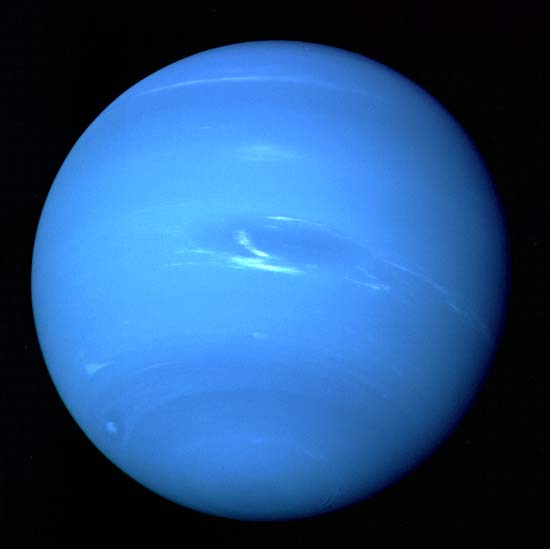
Neptune is also a bit less exotic than its neighbor Uranus in that its dynamic properties are normal. Its axis is inclined at an Earthlike 28.8 degrees. It is 49,500 km in diameter that makes it 3000 km, or 6 percent, smaller in diameter than Uranus. Neptune is so far from the Sun (nearly 4.5 billion kilometers away) that it takes 165 years to complete one orbit. Strange as it may seem, Neptune has yet to complete one orbit since it was discovered in 1846. The Voyager measurements refined the length of a Neptunian day, showing that it rotates once every 16 hours. The temperature near the cloud tops is very low, only 69 K, but the temperatures at the surfaces of the moons are even lower. Daytime temperatures hover near 38 K on these satellites. The magnetic field of Neptune is distinctive but relatively small, only a fraction of that developed in Earth. Like the field at Uranus, the pole of Neptune's magnetic field is tilted compared to the spin axis. The center of the field is also displaced from the center of the planet.
Neptune has a system of at least fourteen moons; their sizes are compared in the table at the beginning of Section 12.5 The Satellites. Triton is quite large; with a diameter of about 2700 km, it is somewhat smaller than Jupiter's Europa. The other moons all have diameters of less than 500 km. The surfaces of the moons are very cold; temperatures on Triton hover around 37 degrees above absolute zero---the temperature at which molecular motion stops. Ices, not stable on the warmer moons of the solar system, have thus formed on these satellites. It is the geology of these ices, not silicate rocks, that we must attempt to understand. The new data from Voyager also showed the presence of several narrow rings around Neptune, resolving the decade-long debate over the possible presence of rings.
Because of their broadly similar diameters, densities, and locations in the solar system, Uranus and Neptune are thought to have similar internal structures. A model for the interior structure of Neptune is shown in Figure 12.2. The model has similarities to those discussed for both Uranus and Saturn. Neptune is thought to possess a core of rock and metals, with an ice water-dominated mantle, and a thick atmosphere of hydrogen and helium. Although smaller in diameter than Uranus, Neptune is more massive (approximately 17 times greater than Earth) and consequently has a density of 1.64 g/cm3, roughly one-third denser than Uranus. These differences suggest that Neptune possesses a larger proportion of dense rocky materials than Uranus. Otherwise, the interiors of the two planets are probably similar. The core of Neptune is probably about the size of the entire Earth but the mass of the rocky core is about 1 to 3 times that of the Earth. Because of the enormous pressure, the rocky materials would have higher densities than Earth itself. Slightly less than half of the mass of Neptune may be icy materials that form a thick mantle around the rocky rock. The icy mantle contains about 10 to 15 times the mass of Earth and is 20,000 to 30,000 km thick. The principal ice is probably water, but ices of methane (CH4) and ammonia (NH3) are probably important constituents as well. Methane and ammonia, not present in any abundance at Jupiter, probably precipitated from the ancient nebula in the cool fringes of the outer solar system. Remember, even though we commonly call this material "ice," it is actually a hot fluid at the temperatures (a few thousand degrees) and pressures found inside Neptune. Under these conditions, some of the water becomes ionized--meaning it has lost an electron that is free to roam; hence, the mantle is electrically conductive which is important for the generation of a magnetic field. From measurements of Neptune's density and rotation rate, it has been deduced that some rocky components may be mixed in with the icy mantle.
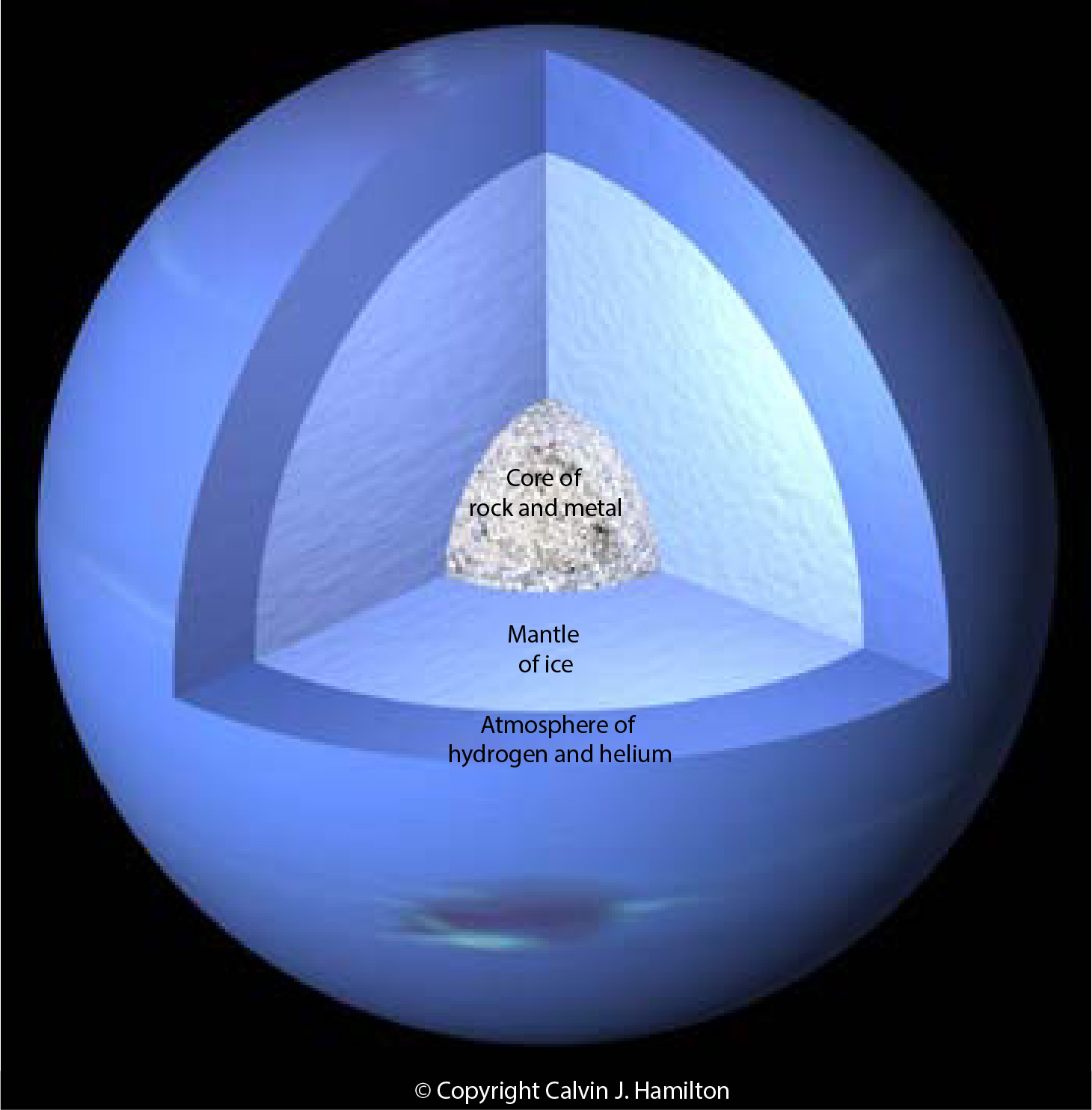
From the information already in hand, it can be deduced that the bulk compositions of both Uranus and Neptune differ markedly from the nearly solar compositions of Jupiter and Saturn. The compositions of Jupiter and Saturn more nearly reflect the composition of the nebula from which the planets formed. For example, Neptune and Uranus are enriched in methane, compared to the composition of these other planets or, for that matter, of the Sun itself. This enrichment probably exists because a larger proportion of carbon was contributed to Uranus and Neptune by the solids that condensed in the cool fringes of the nebula. Carbon may have been in the form of carbon monoxide or carbon. Subsequently, carbon and hydrogen may have reacted to form the methane now seen. Another important difference between Jupiter-Saturn and Uranus-Neptune is reflected by the much thinner, gaseous envelopes of Uranus and Neptune. When compared to Jupiter or Saturn, these two planets are substantially depleted in hydrogen and helium. This is probably because, during the accretion process, the rock and metal cores of Uranus and Neptune did not grow as large as those parental to Jupiter and Saturn. Therefore, they did not retain massive atmospheres of hydrogen- and helium-rich nebular gases.
Neptune has a small, but significant, magnetic field. The strength of Neptune's magnetic field is the weakest of the giant planets and is only about one-fourth that of Earth's. Neptune's magnetic field has a surprising orientation. The magnetic axis is tipped relative to the spin axis by about 50 degrees. When the tilted magnetic field of Uranus was discovered, scientists suggested that Voyager had caught the field in the middle of a reversal (when the magnetic north and south poles switch places). Magnetic polarity reversals are known to occur rapidly on Earth; subsequently, the field keeps the same orientation for millions of years. Thus it seems that the possibility of finding two planets both experiencing magnetic polarity reversals simultaneously is small. Another explanation may be necessary. Moreover, Neptune's magnetic field is not centered in the middle of the planet but is offset about 10,000 km toward the south rotational pole. Thus the magnetic field surrounding the planet is extremely complex, and its orientation with respect to Neptune's orbit is constantly changing. Voyager 2 entered the field at a time when the southern magnetic pole was pointed directly toward the Sun. These significant differences suggest that the mode of generation of magnetic fields in Neptune and Uranus may differ substantially from that which generates the fields that envelop Saturn and Jupiter. As we have explored the outer solar system, we have found increasingly complicated magnetic fields surrounding the planets. The implication is that the dynamo-generating region is not as deeply seated as in Jupiter (or Earth, for that matter) but closer to the surface. Could it be that the electrically conductive medium that generates the magnetic field is not in the center of Neptune, but resides in its watery shell (Figure 12.2) where electrically charged ions can exist? Could convection in such a shell produce a magnetic dynamo?
The gaseous outer layer of Neptune, like those found around Jupiter and Saturn, consists principally of hydrogen (H2) and helium (He), which are the most abundant elements in the solar system. Methane (CH4) exists in an abundance of several percent. Traces of acetylene have also been detected. As in the atmospheres of Jupiter and Saturn, carbon dioxide and other oxidized gases are present in minor quantities. The contribution of the gas layer to the mass of Neptune probably amounts to about 10 percent. At the base of the atmosphere, the temperature and pressure are much higher than at the cloud tops. In fact, at a depth of 7,000 km or more, methane (CH4) gas may decompose and release hydrogen according to high pressure experiments done here on Earth. The left over carbon may crystallize as solid diamonds (C)! Because of their higher density, the diamonds fall downward like hailstones to accumulate at the base of the atmosphere.
The cloudy, banded atmosphere of Neptune is the most striking visual difference between Uranus and Neptune (Figure 12.1). Bands of varying brightness are apparent on all of the images of Neptune's atmosphere returned by Voyager. In contrast to the case for Uranus, no special processing of the images was needed to make the circulation of the atmosphere apparent. The apparent surface of Neptune is created by a deck of thick clouds and haze in its upper atmosphere. Two dramatic dark spots are visible in the southern hemisphere. These deep blue, ovoidal spots seem to change shape as they churn around in a counterclockwise direction. The dark spots are probably great, hurricane like storms in the atmosphere, like those found in the atmospheres of Jupiter and Saturn and best exemplified by Jupiter's Great Red Spot. The Great Dark Spot is the larger and more northerly of the two dark spots (Figure 12.3). It lies at a latitude of about 20 degrees south, the same position as Jupiter's Great Red Spot. The more-southerly dark spot lies at about 50 degrees south and looks like a large cyclopean eye peering out into blackness of space (Figure 12.4). These vast, rotating storms are relatively permanent features and probably result from shear between streams of winds moving in different directions; winds with velocities of over 100 km/hr race through the atmosphere. Towering above the dark spots are brilliant white clouds of methane ice. Constantly changing, wispy clouds form on the southern margin of the Great Dark Spot, but they do not rotate with the spot because they are much higher in the atmosphere. Bright clouds also develop in the core of the smaller, more-southerly storm system. These clouds extend at least 50 km above the bluish deck of haze below them.
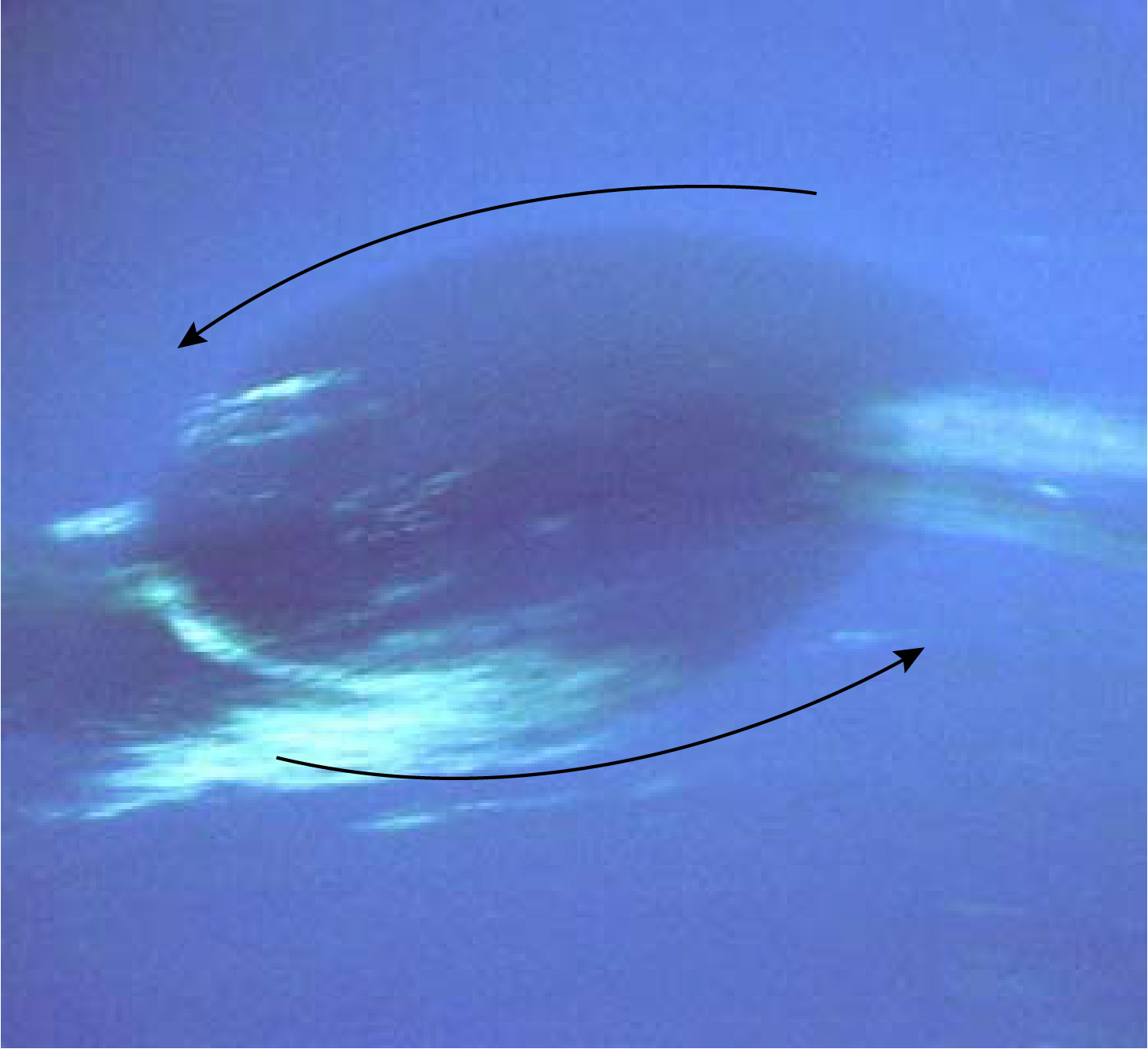
What could cause the appearance of the atmospheres of Uranus and Neptune to be so different? The circulation of the atmospheres of the inner planets is driven in large part by solar energy and the rotation of the planet. If these were the source of energy driving the motions in the atmospheres of Neptune and Uranus, we would expect that Uranus, closer to the Sun, would have a more vigorous atmosphere. Perhaps the answer lies in an important difference between these giant planets. Neptune radiates a comparatively large amount of energy from its interior; Uranus emits almost no internal heat. Another difference between the planets that could account for some atmospheric differences lies in the tilt of the spin axes of the two planets. Much of the heat that reaches Uranus from the Sun falls on its rotation poles, whereas solar energy is most intense at the equator of Neptune, as it is on most planetary bodies. Perhaps the difference in internal heat and the orientation of the spin axis creates stronger atmospheric circulation at Neptune.
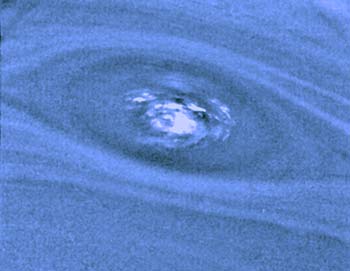
Although planetary rings are common in the outer solar system, the various ring systems are quite dissimilar. Jupiter possesses a narrow diffuse ring; Saturn is encompassed by a spectacular, bright system of broad rings over 70,000 km across with thousands of individual rings; Uranus has nine narrow rings made of dark particles; and Neptune's recently described rings contain clumpy arcs (Figure 12.5). The rings of Neptune were first found by patient observers using telescopes on Earth who suggested that the rings were incomplete arcs that extended only part of the way around the planet. The true character of the rings was revealed by the Voyager images.

The rings of Neptune are a family of three principal rings and several diffuse sheets with different concentrations of small dark particles, all in orbit about the planet (Figure 12.5). The rings lie between 42,000 and 63,000 km from the center of Neptune. Four moons lie within the ring system. If they should become torn apart by impact or tidal disruption, a spectacular ring system like Saturn's could be created. Like other planetary ring systems, the rings lie within the Roche limit, implying that tidal disruption or halted accretion are somehow important in their generation or in keeping the small ring particles from recombining to form a larger moon. The brighter streaks that appear in images of the outer, or main, ring (Figure 12.6) have been called ring arcs. They range in width up to about 15 km and extend up to 50,000 km along a given orbit. The leading edge of each arc seems to fade away, while the trailing edge of the arcs looks more sharply defined. The clumps appear to consist of higher concentrations of dark particles. Features similar to the ring arcs are found in the F-ring and embedded in the gaps found in Saturn's rings; these features must be produced by the same processes. The continuous parts of the rings are so tenuous (Figure 12.6) that they could not be detected from Earth. Between the rings, extending toward the planet from the diffuse inner ring, are particles widely distributed in zones or sheets reminiscent of the broad rings of Saturn, but populated by much smaller concentrations of dark particles. The innermost dust sheet is similar to Saturn's D-ring.
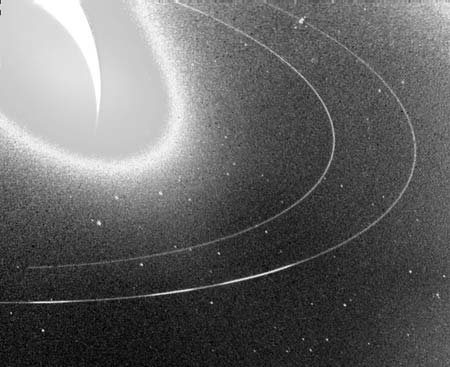
The dark ring-particles are probably produced by the same mechanism that produced the dark ring-particles of Uranus. The surfaces of the smaller moons of these two planets are also relatively dark, and some scientists think that the dark moons and dark ring-particles have a common origin. They suggest that both consist of radiation-darkened methane ice. Compared to the Uranian rings, however, Neptune's rings are populated by smaller particles. Dust-sized particles constitute from 30 to 60 percent of the main rings. Only the diffuse ring associated with the middle ring (Figure 12.5) appears to lack large proportions of dust.
How can a ring system with ring arcs be maintained? One explanation might be that the arcs consist of particles collected at the Lagrangian points of a small moon. These stable points lie in the same orbital path as another larger object, but precede and follow the larger object by 60 degrees; for example, two of Saturn's moons have Lagrangian satellites. Others have suggested that each ring arc is defined by a small shepherd satellite that pulls the ring particles into clusters. Four of the six newly discovered moons of Neptune (Despina, Galatea, Thalassa, and Naiad) lie within the ring system. Proteus and Larissa are too far away to affect ring properties. If shepherd satellites exist, they have not yet been discovered. However, newly discovered Galatea has an inclined orbit and might be pulling some particles into these arcuate clumps. Another alternative being explored by some scientists is that the arcs are composed of fragments of a relatively recent fragmentation of a small satellite. With the passage of time, the fragments could spread out along the orbit to form a continuous, smooth ring. Such impact fragmentation may be an important ring-forming process for all of the outer planets.
Neptune's system of large satellites is smaller than that which surrounds Uranus. Only three satellites larger than 300 km in diameter have been discovered (compared to 5 at Uranus), and one of these was discovered by Voyager 2, which also discovered five other small moons (Figure 12.7). Triton and Nereid were discovered by telescopic observations and are the classical moons of Neptune. In all the solar system, these two moons have the strangest orbital properties (Figure 12.8). Triton revolves about Neptune in a retrograde direction, and Nereid has an extremely eccentric orbit that takes it millions of kilometers from Neptune. In fact, it takes Nereid almost as long to orbit Neptune as it takes Earth to orbit the Sun. The density of Triton and brightnesses, or albedos, of the satellites suggest that, like those of Uranus, they consist largely of mixtures of methane darkened water ice and rock. Spectral observations show that ices of nitrogen and methane are important at the surfaces as well. Below we discuss the satellites in their order outward from Neptune.
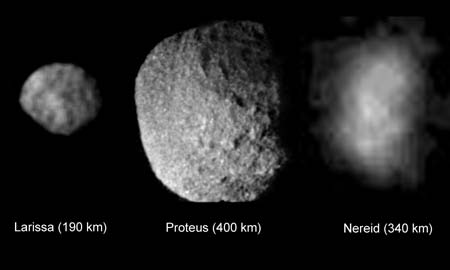
Voyager 2 discovered six satellites embedded within and near the ring system of Neptune (Figure 12.7). From this information their approximate sizes and orbits have been calculated. All these satellites are dark, like the moons of Uranus. Five of the satellites are quite small and, as noted above, four orbit within the ring system but only one appears to be a ring shepherd. None were photographed closely enough to resolve any of the details of their surface features, but they appear to have irregular shapes.
Proteus is the largest and orbits just outside the ring system. It completes an orbit every 1.1 days. This satellite is almost as large as Saturn's Mimas, and yet it is not spherical (Figure 12.7). The outline of the body is trapezoidal, with a shape like a rounded cobble. We pointed out earlier that Mimas barely had enough gravitational energy to pull itself into a sphere; apparently Proteus did not have quite enough mass to deform its surface into a spherical shape after the last events that shaped it. Vague, nearly circular features are discernible on its surface, and a large trough appears to extend from north to south across the face of the satellite. Most likely, Proteus was shaped by impact. Like the ring particles, Proteus is very dark and reflects about as much light as does soot. The dark coloration of Proteus, and the other small moons, is probably the result of radiation damage of methane ice at the surface.
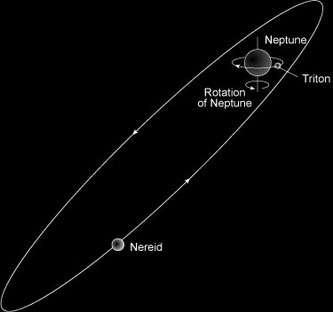
Triton is Neptune's largest satellite (2700 km in diameter), comparable in size to Jupiter's Europa and Io or to Earth's Moon (Figure 12.9). Some of the most spectacular images taken by Voyager 2 were the high resolution views it provided of Triton. The various geological processes and features found on Triton remind us of bodies as complex as Mars, Europa, Ganymede, Enceladus, and Ariel. Before we discuss the geological terrains of Triton, we need to discuss several of its unique properties, including its orbital characteristics and the composition of the ices on its surface.
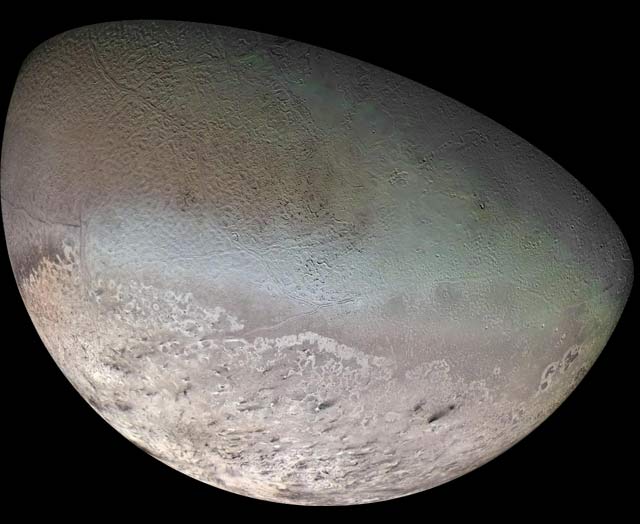
Like Nereid, Triton has remarkable orbital properties. Although Triton is like most other moons in that it has a nearly circular, synchronous orbit and always keeps the same face pointed toward its primary, Triton revolves about Neptune in a retrograde fashion (that is, it revolves about Neptune in a direction opposite to the planet's rotation). Triton is the only large satellite in the solar system to do so. In addition, the orbital plane of Triton is tipped at an unusually steep 21 degrees away from the planet's equator. Because of these peculiarities, its orbit is very slowly decaying. It has been calculated that within about 10 billion years Triton will pass within Neptune's Roche limit; however, this is longer than the remaining life of the Sun. A retrograde orbit cannot originate by simple accretion of a moon from debris in orbit around Neptune. Triton's strange orbit suggests instead that it was gravitationally captured by Neptune after the satellite formed elsewhere, perhaps destroying an originally larger system of satellites in the capture process. Others have suggested that Triton's unique orbit is the result not of capture but of a large collision with another planetary body sometime in its past. Both hypotheses require some sort of cosmic catastrophe. Moreover, in either case, Triton's early orbit would have been very eccentric. The fact that Triton's orbit is now nearly circular almost demands that, during its orbital evolution toward a circular orbit, large tidal forces were exerted on it as Triton alternately drew near to and far from Neptune. Calculations of the amount of energy produced by this tidal flexing suggest that Triton may have been heated dramatically while the orbit became circular. Thus, although the orbit may have become circular rapidly, the heating may have kept Triton's interior warm for a billion or more years after it was captured. What evidence would we look for to test this hypothesis? The surfaces of the Galilean satellites of Jupiter should give us a clue.
Triton is remarkable, too, in that ices of methane (CH4) and nitrogen (N2) have been identified on its surface. In fact, methane may be more common at the surface than water ice. There is no spectral evidence of water ice, yet. The photos of Triton may show us the only detailed view of such an exotic surface. Triton's surface temperature is extremely low at 37 K and is the coldest object we have yet visited. Nonetheless, sublimation of methane and nitrogen ices contributes to a transparent and very tenuous atmosphere with a current surface pressure of 0.01 mb, just a tiny fraction of that present on Mars (6 mb on average). Nitrogen is more abundant than methane in the atmosphere because it is more volatile than methane and has a higher vapor pressure. Titan, Saturn's largest satellite, and Earth are the only other planetary bodies in the solar system known to have nitrogen-rich atmospheres. If by some cosmic juggling process Earth could be moved to the position of Triton, it would possess a shell of nitrogen ice nearly 15 m thick.
However, a simple, globe-encircling shell of nitrogen ice has not developed on Triton, for good reason. As noted above, Triton's orbit about Neptune is inclined; in addition, Neptune's spin axis is also inclined. These tilts cause Triton's polar regions to point toward the Sun occasionally during a complicated cycle of seasons within seasons that lasts about 600 years. At one extreme, the polar axis of Triton tilts 40 degrees toward the Sun, basking in constant sunlight, while the other is in constant shadow. These seasonal changes are enough to produce significant variations in the amount of solar energy that reaches the surface of Triton over the course of a season. Consequently, there may be large seasonal variations in the position and extent of a polar cap of nitrogen ice. Voyager photos show that the present nitrogen ice cap extends across most of the southern hemisphere nearly to the equator (Figure 12.9). The southern hemisphere of Triton is tilted now toward the Sun; summer in the southern hemisphere will peak about the year 2000. As summer sets in, nitrogen in the ice cap should be vaporized, and the cap of ice will shrink and may disappear completely. At the same time winter holds sway in the northern hemisphere and nitrogen should freeze out of the atmosphere forming a cap of ice that gradually grows southward. The atmosphere functions as the transport medium as nitrogen flows back and forth between the poles. Thin hazes and clouds seen in the atmosphere of Triton may be graphic evidence of the cycling of volatile materials from one pole to the other. The intricate patterns along the margins of the southern ice cap (Figure 12.10) appear to result from sublimation. The southern hemisphere is now moving into its summer season. We would predict that a north polar cap is developing, which was out of view of Voyager's cameras at the time it flew by. Triton joins Mars and Earth as planetary objects that possess polar ice caps that change with the seasons.
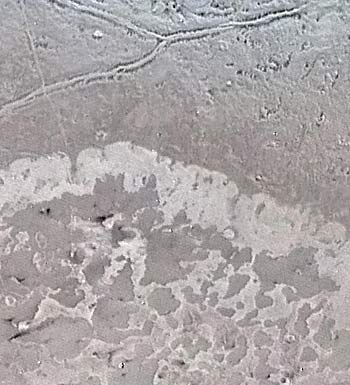
Now let us focus on the surface geology of Triton, unlike anything else in the solar system. Based on superposition and surface features, three distinctive types of terrain were identified on Triton. From oldest to youngest they are (1) highly fractured plains, (2) flooded volcanic plains, and (3) the polar ice cap. Significantly, no heavily cratered terrains are present on Triton.
Fractured Plains (Cantaloupe Terrain). As revealed in the images taken by Voyager 2, much of the surface of Triton may consist of relatively dark plains crisscrossed with many linear fracture systems (Figure 12.11). Most of the fractures appear to be the result of rifting of the lithosphere to form fault-bounded grabens. Some grabens are over 1000 km long, and even the youngest intersect one another at high angles. Many of these fractures have been filled by linear protrusions, or ridges, that rise above the surrounding terrains. The most straightforward interpretation of these fracture-fillings is that they were fashioned by a form of icy volcanism, similar to that seen on other satellites such as Enceladus and Ariel. Nonetheless, the well-defined character of these linear strands shows that they were not formed by flooding from a fluid like liquid water. Instead, they seem to be extrusions of a viscous, perhaps nearly solid, material. The composition of these volcanic flows could range from water to watery mixtures with ammonia or methane. Either of these latter two compounds, when added to water, will reduce the melting temperature of water and make the production of watery magmas more likely below the frigid surface of Triton. The presence of ammonia may have increased the viscosity of these flows.
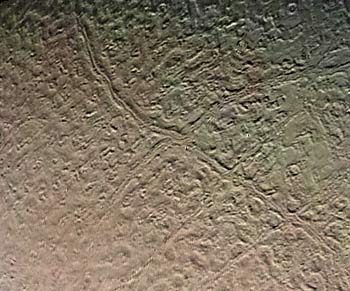
The terrain across which the young fractures cut appears to consist of similar but older and more subdued fractures and icy volcanic flows. Perhaps this terrain has a long history of repeated fracturing and volcanic activity. The fractures have allowed molten, or partially molten, material from inside Triton to well up on to the surface. The multiple generations of fracturing have created a very complex topography of irregular depressions and narrow ridges that together create a surface that looks something like the pitted and ridged skin of a cantaloupe (Figure 12.11). Locally, it may overprint older cratered terrains.
The fractured regions of Triton are its oldest terrains, but they are not heavily cratered like many of the moons of Uranus and Saturn, nor are they as lightly cratered as the volcanoes of Io or the plains of Enceladus. The impact crater frequency on these surfaces is similar to that found on the lunar maria. If the flux of impacting bodies was about the same on Triton as it was on the Moon, then these terrains must be less than 3 billion years old.
Flooded Volcanic Plains. A fascinating terrain unique to Triton cuts across or covers portions of the fractured plains. It consists of relatively smooth plains cut by arcuate scarps and large shallow depressions that are elliptical to subcircular (Figure 12.12). The irregular depressions have many similarities to the floors of the large collapse calderas found atop the volcanoes of Earth, Mars, and Io. Some flat areas several hundred kilometers across are bounded by low scarps 200 to 400 m high. This region appears to have been shaped by floods of fluid volcanic liquids forming large lava lakes---a different kind of icy volcanism than that in the cantaloupe terrain. Floods of softer, hotter, and more fluid lavas seem to have been involved. The composition of these lavas is unknown but could consist of a mixture of water, nitrogen, and methane, with a low melting point. Low ammonia contents would make these liquids more fluid. The floods appear to have accumulated in lakes or to have ponded in calderas. Multiple levels of cooling and stagnation are apparent. In many places, it appears as if a volcanic liquid cooled to form a solid lid, then drained away beneath part of the lid, causing that part to founder and melt. Cooling of the new lower level of liquid created another lid next to the higher, older level. These depressions can be interpreted as volcanic calderas themselves or as the result of the accumulation of fluid lava flows in preexisting depressions. These alternatives can be thought of as the caldera versus the lake hypotheses. The fundamental distinction between them lies in the location of the vent and the magma body it taps. A caldera has a magma body beneath it, into which the roof collapses to create a depression; a lava lake can accumulate in any kind of depression and need not lie above the chamber that fed its lava flows. Complex superposition relationships between many generations of these floods and their partially collapsed surfaces have created the multitude of scarps in this region of Triton.
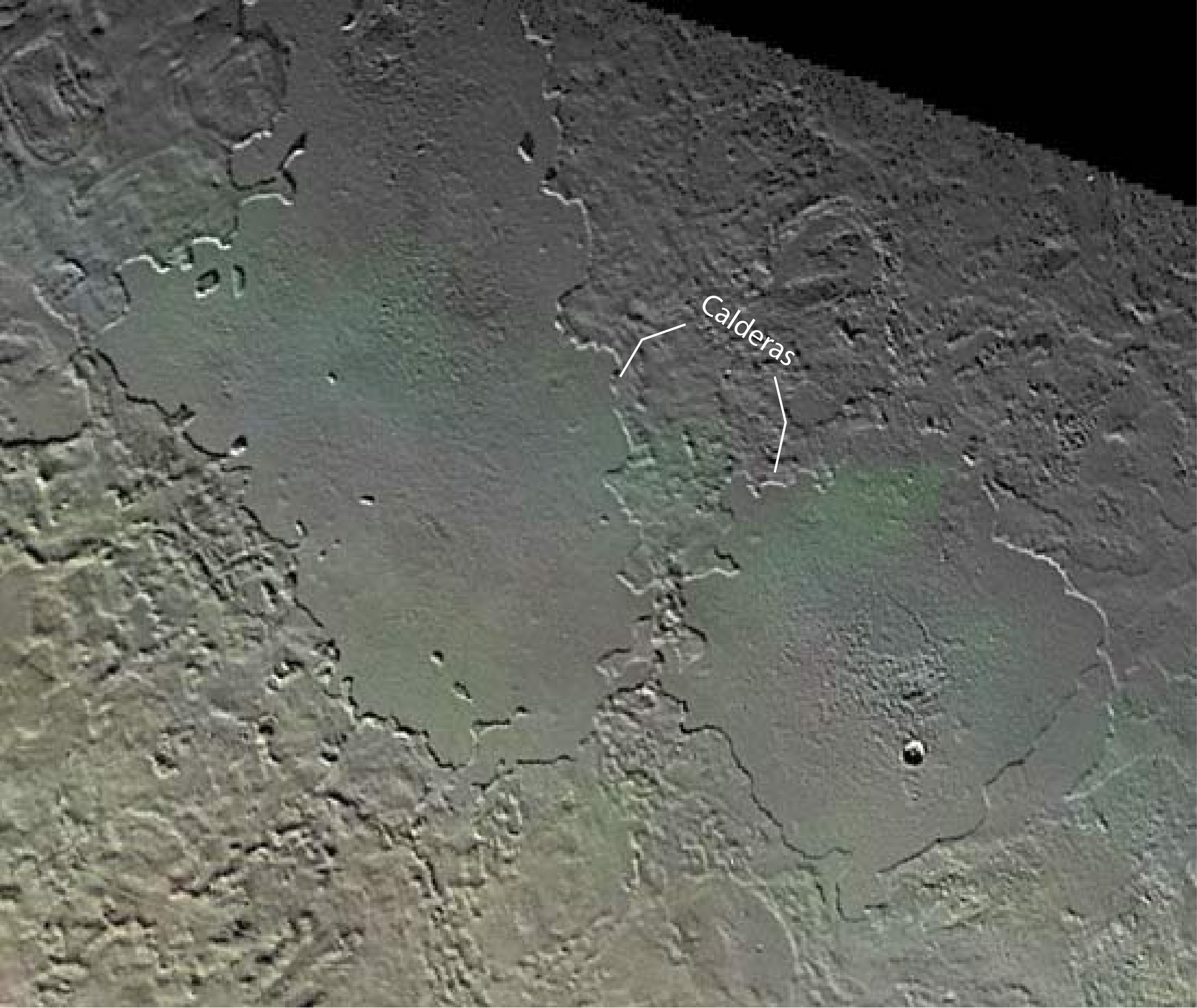
The flooded plains are superimposed on and less cratered than the fractured, cantaloupe terrains, but many, relatively small, impact craters are present and imply that the plains formed within the last several billions of years.
Polar Ice Cap. The youngest and brightest terrain on Triton is the large bright ice cap that covers the south polar region and extends nearly to the equator. Triton is one of the few planetary objects that has an ice cap. Both Earth and Mars have frozen ice caps, water on the one hand, and water and carbon dioxide on the other. Ice caps serve as important, but relatively temporary, sinks for atmospheric volatiles.
Triton's ice cap reflects nearly 90 percent of the sunlight that falls on it and is one of the brightest surfaces in the solar system. Clean, freshly fallen snow reflects about 75 percent of the light that falls on it. Measurements made from Earth suggest that the cap is composed of nitrogen ice. After the identification of nitrogen on Triton, speculation about Triton included the possibility of seas of liquid nitrogen. Perhaps it would have been appropriate that Triton, mythical son of the sea god Neptune, should have had a sea, even one of liquid nitrogen. As it turns out, Triton is too cold for a nitrogen ocean to exist as a liquid, and an ice cap has formed instead.
The ice cap is probably a constantly changing feature of the landscape of Triton. Presently, the outline of part of the cap is roughly polygonal (Figure 12.9), rather than smoothly lobate as are other planetary ice caps. The northern edge of the cap nearly reaches the equator of Triton. The northern limit is extremely irregular with many patches of darker terrain apparent behind the front. These darker patches probably are exposures of the underlying terrains. The irregularities of the cap appear to be the result of sublimation of the nitrogen along low scarps or by the deposition of bright ice in irregular low spots. The polar cap must change shape and thickness with the complicated seasonal cycles on Triton. Around the rim of the ice cap, but on other, older terrains, a bright halo exists (Figure 12.10). The halo may consist of frosts of ices that condensed onto the surface where the temperature was lower near the edge of the cap.
Volcanic Eruptions. Enigmatic dark streaks are apparent atop the ice cap near its northern margin (Figure 12.13). These streaks are perhaps the most intriguing features identified on Triton. In actuality, the streaks are not as dark as they seem in this specially processed photograph and are really quite bright (about the brightness of snow). They appear dark here because they are significantly darker than the very bright background. Most of the streaks in the photographed area are aligned parallel to one another in a northeasterly direction. Each streak has a roughly triangular outline, with a well-defined southern apex and an irregular, diffuse northern termination. The apexes of some streaks arise from what appear to be small circular patches on the ice cap. After studying these streaks with stereoscopes so that their three-dimensional character could be seen, scientists discovered that they are eruption plumes of active volcanoes. Triton thus joins Earth and Jupiter's moon Io as the only known planetary bodies with active volcanoes. Several eruptions were identified. The pictures show dark vertical plumes rise to heights of nearly 8 km before Triton's winds sweep the volcanic ejecta across the sky. But Triton's volcanism is unlike that on Earth or Io. It is apparently powered by the vaporization of liquid nitrogen or methane. Indeed, the volcanism on Triton may be more like geysers on Earth. The "magmas" in these small volcanoes may form as slightly higher temperatures are reached below the surface of the cap or as ices melt at the surface to form small pools. No special heating process is required; rather, the melting point of nitrogen or methane ice is reached because of the natural temperature gradient that probably exists on Triton. Higher spring and summer temperatures may cause cyclical volcanic seasons. If liquid nitrogen is formed at the base of the ice cap, it can rise because of its lower density; but before it can extrude onto the surface as a quiet lava flow, it reaches its boiling point and explodes violently because of the tremendous volume change that occurs when liquids convert to gases. The darker color of the streaks could be caused by radiation-darkened methane particles entrained in the eruption blast and scattered in a small eruptive plume across the surface of the ice cap. The preferred alignment of the streaks must be the result of prevailing winds sweeping across the cold cap toward the warmer equator. All of the dark streaks are very young. They have developed on top of a polar ice cap that buries all other terrains on the planet; if our theories of seasonal variation are correct, the cap may be only a hundred years or so old, and, thus, the volcanoes could be this young, too.
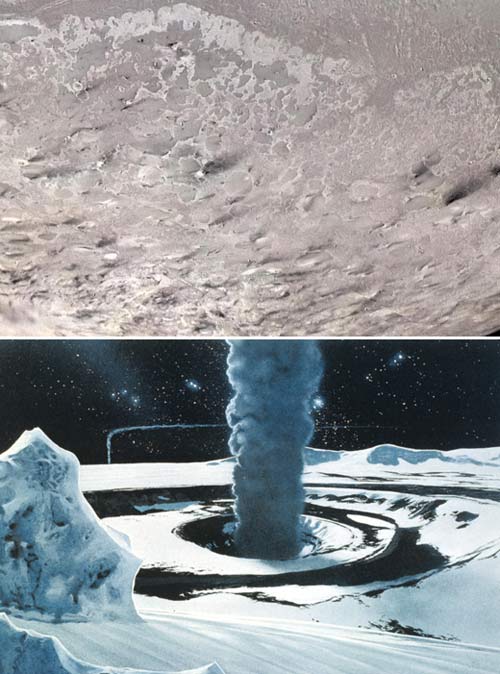
Interior and Composition. The density of Triton is about 2 g/cm3; apparently it consists of about one-third ice and two-thirds silicate rock. When we compare the densities of the satellites of Saturn (1.2 to 1.4 g/cm3), Uranus (1.4 to 1.7 g/cm3), and Neptune (2.0 g/cm3), a distinct trend of increasing density with increasing distance from the Sun emerges. This systematic change in density has given rise to speculation about the proportions of ice and rock inside these small bodies. Perhaps the proportion of low density ice in the outer part of the nebula was reduced, compared to dense silicates. This could have happened if volatile carbon monoxide (CO) existed in preference to water or methane ice because of the lower pressure and temperature in the nebula near Neptune and Uranus, than around Saturn. The resultant mixture of solids could contain more dense rocky solids and less ice.
Another aspect of the geology of Triton is uncertain---is its interior differentiated? Presently we don't know, but if Triton is indeed a captured planetesimal, then the exchange of energy that occurred during capture may have led to extensive internal melting and differentiation of the satellite.
Geologic History. Apparently, Triton accreted from icy materials enriched in rocky components compared to ice (water, methane, and ammonia) in the outer part of the solar system. Accretion probably formed a heavily cratered surface. At some point early in its history as a Sun-orbiting planetesimal, it was captured by Neptune's gravitational net and placed in a retrograde orbit. The ensuing circularization of its orbit produced great tidal interactions between Neptune and Triton, heating and probably differentiating Triton. The heat drove tectonic and volcanic processes on Triton for perhaps as long as 500 million years afterward. Volatile gases (methane and nitrogen, produced by the decomposition of ammonia) were released from the ices that once contained them to accumulate at the surface. A thin atmosphere was created, but much of it condensed to form a sheet of nitrogen ice at the coldest spot on the planet---the pole experiencing winter. The location and details of the polar cap have changed constantly throughout the millennia of seasonal changes that followed.
Again, Voyager has revealed the characteristics of an enigmatic satellite. Triton, with a diameter of less than 3000 km, has a young surface. Tectonic rupturing of its surface obliterated all of the heavily cratered terrain that probably developed following its accretion. Associated with the tectonism, repeated volcanic outpourings were important parts of its relatively recent geologic history (the last several billion years). If icy Triton had been left to its own devices---its own radioactive and accretionary heat sources---geologic activity would not have persisted beyond the period of intense bombardment. Thus the evidence from its orbital properties and the youthfulness of its surface features are both consistent with a geologic scenario calling for the gravitational capture of Triton after its accretion elsewhere (but not too far away) in the solar system. The resulting modification of captured Triton's orbit raised large tides in its lithosphere, heated its interior, and remolded its surface. Enough heat was apparently created to keep Triton warm for some billion or so years after capture.
The presence of icy materials on its surface, and presumably in its interior as well, with very low melting points may also have extended the duration and nature of geologic activity on its surface. Nitrogen forms a liquid at temperatures that may be encountered only a short distance beneath the present surface of Triton. When materials are liquid or at least soft enough to flow and deform, internally driven geologic processes can create new surfaces and modify old ones through tectonic and/or volcanic processes.
Nereid, the outermost satellite of Neptune, has a diameter (340 km) in the same class as, but significantly smaller than, Uranus' Miranda or Saturn's Mimas. Nereid has a highly inclined and eccentric orbit (Figure 12.8). At closest approach, it is within 1.3 million km of Neptune; its most distant point lies 9.7 million km away. For Nereid to complete one revolution around Neptune requires 359 Earth days. Because of this strange orbit, it has been speculated that Nereid may be a captured, outer solar system asteroid, or that it formed as a satellite nearer Neptune but was sent into its present orbit when Triton was captured. The capture of Triton profoundly affected the satellite system. The present satellites may have accreted from the debris of an earlier satellite system destroyed by Triton's capture.
Pictures of the surface of Nereid obtained by the Voyager spacecraft were taken at a great distance and therefore they do not show any details about its surface geology. However, the images do show that Nereid is not round and has the irregular appearance of many small, solar system objects shaped by collisional fragmentation. As it rotates, Nereid shows marked brightness variations, either as the result of its irregular shape or because of bright and dark surface markings like Iapetus.
The characteristics of Neptune continue the trends established for the planets of the outer solar system. Composed mostly of ice and rock and with less hydrogen, Neptune is slightly more dense than Uranus---apparently the result of having slightly more rock in its interior. Like Uranus, Neptune is circumscribed by narrow rings of dark particles. Clumps of high concentrations of small particles are especially obvious in the ring system, creating ring arcs. Also like Uranus, Neptune has a strangely oriented magnetic field and a thick atmosphere colored by methane. But unlike its neighbor, Neptune emits a significant amount of heat, apparently enough to create visible banding and turbulent storms in its atmosphere unlike any seen at Uranus.
Seven of the eight known moons of Neptune are small, icy bodies about which little is known. Six of the moons were discovered by Voyager 2 and circle the planet in orbits in and near the ring system. These bodies probably formed or are remnants of bodies that formed from a disk of material that rotated around Neptune. On the other hand, the outermost satellite, Nereid, may have originated elsewhere as an asteroid or satellite of another planet. We know most about Triton, the largest of Neptune's moons. It promises to be an exciting object for continued study, with an extended geologic history marked by a multitude of tectonic and volcanic events---some of which are presently active. Its constantly changing ice caps and thin atmosphere also mark it as a distinctive satellite. Exotic ices of nitrogen and methane are found at its surface. Geologic activity was driven after the period of heavy bombardment by the tides raised on Triton when it was captured by Neptune and placed in its retrograde orbit. The importance of distinctive energy sources and materials for the geological history of a planetary body is nowhere more obvious than on Triton.
1. Outline the major differences and similarities between Neptune and Uranus. Consider their orbital properties, sizes, atmospheric compositions, internal structures, magnetic fields, rings, and satellite systems.
2. Neptune has a banded atmosphere with prominent clouds and storm systems; Uranus has a nearly featureless atmosphere. Is there an explanation for this obvious difference between the planets?
3. Prepare a table that compares the diameters, surface compositions, ages, and features of the major satellites of Neptune.
4. Make a graph showing the densities of the satellites of Jupiter, Saturn, Uranus, and Neptune versus their relative distance from the Sun. Explain any apparent trend and anomalies to the trend.
5. Why is the retrograde orbit of Triton important to its geological history? Would the same hold true for the eccentric orbit of Nereid?
6. Compare the origins of the atmospheres of Earth, Titan, and Triton---all bodies with atmospheres dominated by nitrogen.
7. Contrast the apparently volcanic plains of Triton with those of the Moon. What factors cause the differences?
8. If you could design a spacecraft that could land on only one moon of Neptune or Uranus, which would you choose as the most scientifically revealing? What information would you gather?
9. Compare the volcanic activity of Earth, Io, and Triton. Consider major geologic factors such as type of material, melting temperatures, and source of heat.